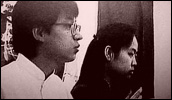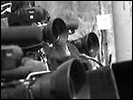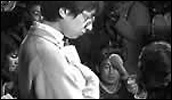A



by Jasper Sharp
"Joking aside, I think there's a real risk of us being demonised," confides one of the members of Aum Shinrikyo (Aum Supreme Truth) to another in the privacy of the infamous religious cult's headquarters in Kameido, Tokyo. It's a classic piece of understatement considering what has now come to light about the sect after it hit the international headlines when, on March 20th 1995, poisonous sarin gas was released at Kasumigaseki station on the Hibiya line of the Tokyo subway system, immediately killing 12 people and injuring almost 4000 (exact figures are rather hard to ascertain - many people have subsequently died or been left brain damaged by the after effects).
The incident sent understandable shockwaves throughout Japan, highlighting the vulnerability of a society that for the past few decades had known only peace and prosperity: more so because in this instance, the danger came from within. But as with all such ground-shaking events, after the immediate explosion of media interest, once the dust had settled, the scapegoats had been rounded up and the furore had subsided, we were still left with a host of unanswered questions. What were the forces that had led to such a seemingly random act of destruction from within the well-ordered fabric of Japanese society? Were all the members of the sect really cold inhuman monsters, or were they simply misguided, brainwashed even? What was the true nature of their relationship with Aum's notorious leader Shoko Asahara? How implicated or even aware of this crime, and others that have subsequently been made public, was anyone in the cult? In short, what sort of people were they?
It is difficult to know what exactly went on beyond the scenes at Aum, such is the opaque nature of any religious cult, especially one that at its height apparently boasted around 17,000 members in Japan, and another 10,000 dotted about in Russia, Germany and the United States. Any large body of people who decide to live a closed-off existence engaged in activities that fall outside of the comprehension of the status quo is inevitably going to arouse suspicion. Opting from the daily routines of normal people, they are also freed from the same degree of social control as the wage-earning, child-rearing, tax-paying man in the street. Incomprehensible, unpredictable: it is understandable that the average person doesn't want these devils on their doorsteps. But can we afford to ignore the symptoms of what prompts these people to withdraw from normal life into this shadow domain of sect membership? Given the shocking and highly emotive nature of the sarin gas incident, and the sense of pervading fear that reigned throughout Tokyo in its aftermath, it would seem that such introspection was a luxury the TV sound-bite driven culture of modern news reporting could ill afford.
Which is where Tatsuya Mori steps in. A former actor (he appeared in Sogo Ishii's 30-minute fiction Shuffle in 1980, and a number of early works by Kiyoshi Kurosawa, including his Nikkatsu produced Kandagawa Wars in 1983) and a TV documentary-maker whose previous work includes a profile on wrestling midgets, Mori spent two years behind the scenes with the cult members during the trial of its charismatic blind guru Asahara (real name Chizuo Matsumoto) in the months that followed the incident. Filmed during the summer of 1996 when the repercussions of the incident were acutely being felt, Mori assembled the stunning documentary A under his own steam after a fall out with his TV producers, who wished only to use the resulting footage as interview clips for news bulletins. Rather symptomatic of the routes by which news content reaches its consumers nowadays, the results were not screened on television at the time they were filmed, and so never reached the broader audience they deserved, initially playing on a limited theatrical run. Fortunately, the film has now been made available on DVD in Japan, with English subtitles and in all its rigorous 135-minute detail.
From the very outset, it's clear that Mori's approach bears a lot more fruit than his newshound contemporaries. With the sect still in existence during the trial, its members in the central headquarters find themselves besieged by the media. Thrust straight into the feeding frenzy of the newsmen's shark feeding pool is Aum's PR spokesman Hiroshi Araki, an awkward, timorous man who seems genuinely in the dark about the nature of the group's responsibility for the gas attacks. Representatives from the various TV news channels wish to shoot interviews and inside footage of the sect's compound, but Araki is stalling, and wants to make sure everyone has the correct authorization before he lets them in.
Shooting it all, Mori takes some pointed jabs at journalist integrity in this sequence, as well as revealing that Araki is pretty naïve about how the media operates. As he focuses on a reporter from Nihon TV who keeps the camera running during Araki's protestations against his wishes, we have to wonder what purpose the resulting images will actually serve.
In the meantime, Mori has already been there amongst the cult members for several weeks, revealing that, as might have been suspected, but certainly not what the public would like to hear, life in the compound is actually pretty dull. Living on a bland diet of vegetable protein and rice, the same meal everyday, the average sect member passes time in abstinence of worldly pleasures and in adherence to the doctrines of Aum, an extreme variant of Buddhism.
Here he captures an interview with one of the cult members, who espouses his philosophy: "Death is inevitable. You grow old and you die. The more you love, the more painful death becomes. Helping someone get beyond these feelings, that's giving them pure happiness. I cut off the feelings of romance and love that I had. Instead, I teach the path of true liberation for the self." We learn that his wife is now also an Aum cult member, based in a different location.
Meanwhile, Mori shoots an interview third-person between a TV representative and her interviewee. The cult member eventually steps back from her superficial questioning, realising that whatever he says about his own personal beliefs, given the nature of the interview and how Aum is currently being scrutinized, no one will be listening to what he is saying anyway. Viewers will reinterpret his answers to fit their own preconceptions. We later see a number of the members gazing blankly at a newspaper tabloid headline "Aum Members Huddle In Seclusion" as Asahara's court case dominates the public imagination.
Using Araki as a hook, Mori's behind-the-scenes footage certainly gives a better insight into the beliefs, philosophies and daily practices of the cult members. One of the members quit university after 3 days after seeing the other students and thinking to himself, "There's no future for Japan" - a remarkably commonplace sentiment amongst Japanese people nowadays, it would seem. He doesn't completely have access all areas though. In one scene, the cult members are seen viewing footage of a rather tense press conference announcing the appointment of its new leaders, two toddling children, where a journalist asks bluntly whether the teachings of Aum directly inspired the attacks. As Mori moves in closer to gauge the cult members reactions to the film, a hand is held up to block Mori's roving camera.
In the early stages of the film, by seemingly ignoring the crucial details of the shocking sarin attacks, Mori's sympathetic portrayal of the individual members of Aum, all of whom come across as frighteningly genuine people, almost seems like a vindication in face of their media persecution. But even if the cult members interviewed seem oblivious to the true nature of their leader's alleged plans, Mori doesn't. As the case progresses and the cult's various bases are closed due to bankruptcy, there is chilling footage of the discovery of a stash of horse syringes and bottles of a strange unknown liquid in a secret storeroom in a temple in Kumamoto prefecture in distant Kyushu, along with a cryptic sheet of notepaper scrawled with strange diagrams and the heading "Advance of Science and the Change of the World View".
The focus begins to change at this point. As the months pass and the cult activities continue, broader issues about freedom of speech and religious practice are raised. A sign informing of counselling for former Aum members provided by the city of Fujinomiya is shown alongside banners proclaiming "Aum, Get Out!". Against the backdrop of the protests of the local inhabitants of Kameido where the group's headquarters is located, individual cult members encounter increasing hostility.
In a truly unbelievable sequence, one of the members is stopped by the local police. Refusing to give his name, he is chased down the street and knocked over. As he lies prone on the ground, the police officer rolls on the ground clutching his shin like an Italian soccer player, and the Aum member is arrested for violent obstruction. It is a clear abuse of power by the police. All of this is captured on camera by Mori, who, unable to remain a neutral third party, reluctantly submits the footage for the court hearing after Aum drafts in the support of a human rights activist.
In the following year, with the knee-jerk threat of the Anti-Subversive law, which threatens to restrict the actions of any political or religious group, individual cult members are again interviewed about their opinions on the gas attacks, and its test on their faith in both their religion and their discredited leader. Araki, clearly worn by the events of the past year, seems disillusioned. "In the two years since joining Aum, I've had to face the temporal world more than any other time."
It was later discovered that the gas attacks were part of a program to overthrow the Japanese government. Two of the five members responsible were executed. Aum was also linked to another gassing in the central Japanese city of Matsumoto in June 1994. Aum later renounced violence, and changed its name to Aleph (the first letter of the Hebrew alphabet, symbolising "A New Beginning"), though still remains under surveillance. Asahara is still on trial, claiming that as the cult grew bigger, he had could no longer be held accountable for the actions of its followers.
These facts are not included in Mori's documentary. There is no footage of Asahara at all, save for a few shots of his portrait on the compound walls. Neither are there any background details given about the gas attack, probably because such things were so well-known to the Japanese public at the time. A's main focus is on the here and now, filling in the broader parts of the story that were all but ignored elsewhere (though it's worth mentioning here writer Haruki Murakami's non-fiction work Underground, which balanced eyewitness testimonials of the surviving victims in the subway at the time with interviews with some of the cult members). Mori shows us life within the group at a time when all eyes were upon them. If the results seem a little unbalanced at times, even in the outside world, opinions on Aum's future in the following years were not as cut and dry as they first appeared. It proved a big enough subject to fill another film, which came in due course in the form of A2, three years later in 2001. But that's another story entirely.